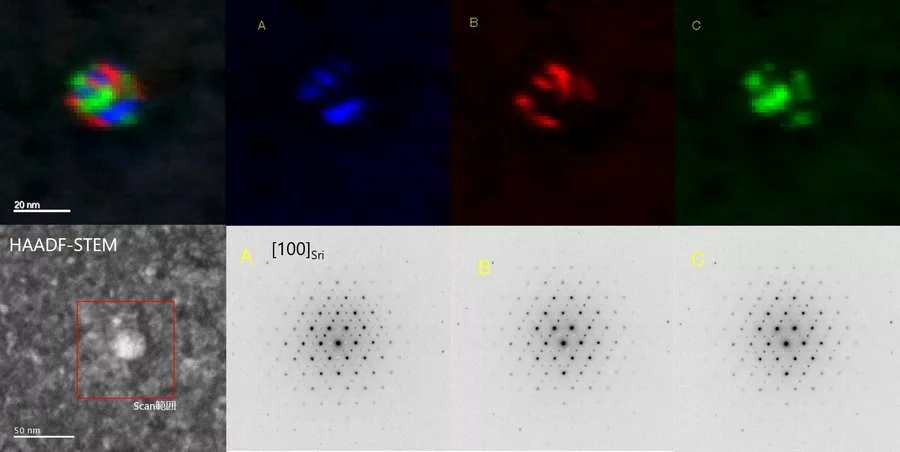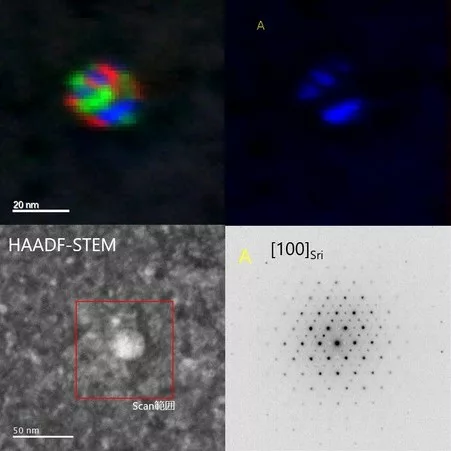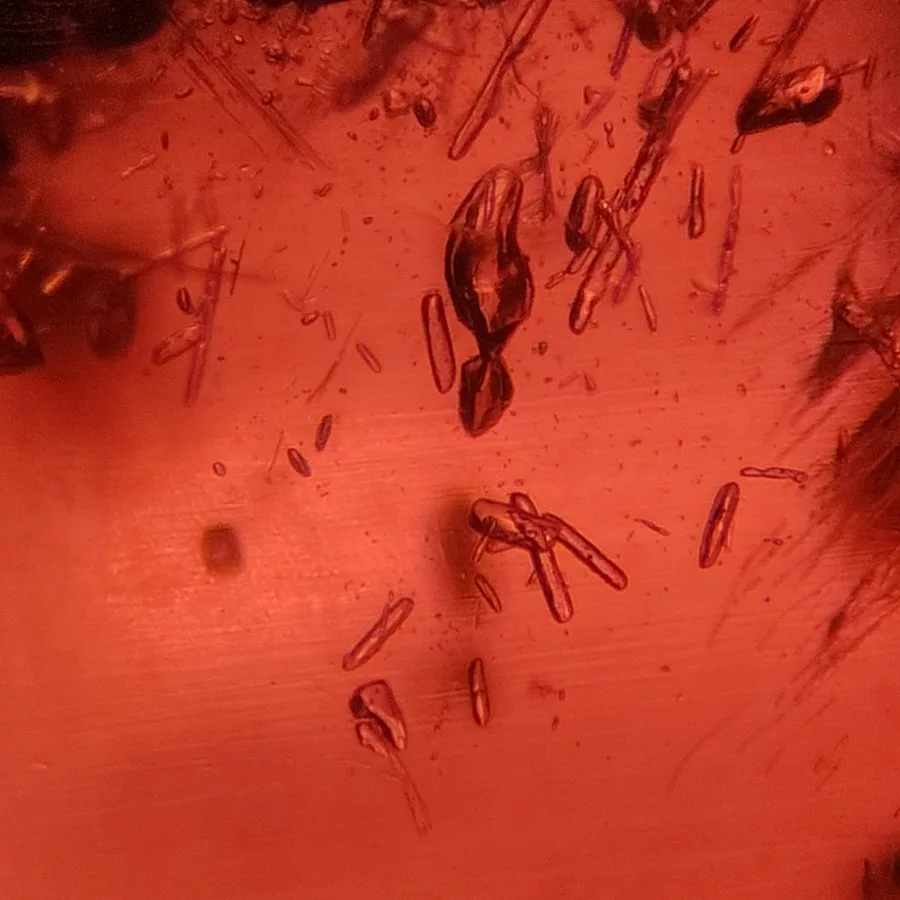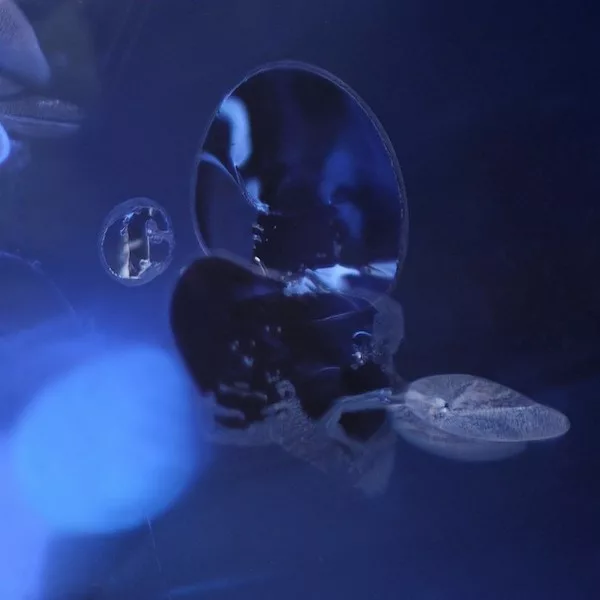Crystal structure of nano inclusions in blue sapphire from Diego Suarez, Northern Madagascar
Abstract
Nano inclusions in unheated blue sapphire (Diego Suarez, northern Madagascar) containing naturally occurring beryllium have been studied. Tabular nano inclusions with a diameter of 20 to 30 nm were observed with transmission electron microscope (TEM). Electron diffraction shows that the nano inclusions are possibly a “srilankite’’-like mineral phase (srilankite: ZrTi2 O6 ) which are triple twinned. In addition, the nano inclusions show epitaxial relationship with the corundum matrix. We estimate that the nano inclusions are a product of exsolution.
Introduction
Since September 2001, Be-diffusion treated corundum has been widely seen in gem market across the world. Initially, it was thought that Be did not exist within untreated corundum, but traces of naturally occurring Be have subsequently been confirmed to be present in untreated corundum (e. g. Wathanakul et al. 2004, Krzemnicki 2007, Shen et al. 2012, and Pardieu 2013 and therein).
Shen et al. 2012 found that clouds in samples from Ilakaka, Madagascar, contain Be and the samples contain nano-inclusions 20-40 nm long and 5-10 nm wide which are unnamed high-pressure mineral that has the same composition as rutile, but has the crystal structure of α-PbO2 . But there was no discussion about Be and nano-inclusions. Emori et al. (2019) showed that nano-inclusions in untreated Be-containing blue sapphire from Diego Suarez, northern Madagascar, contains Ti, Nb and Ta, and that Be is also located in nano-inclusions. Although their crystal structure has not been determined, it may be an unknown mineral which has α-PbO2 structure (Shen et al. 2012) and has the chemical composition of Be: Ti: Nb: Ta = 3:16:1:4. In this study, we made more detailed observations of the nano inclusions discovered by Emori et al. 2019, and report the results.
Materials and methods
In this study, we examined an unheated basaltic blue sapphire rough (sample No.10) from Diego Suarez, Madagascar, containing natural Be. This sample was already studied by Emori et al. in 2019. The sample No.10 has a size of 9.10 x 7.58 x 4.02 mm and a weight of 3.89 ct, and has been polished on one side for observation and analysis. Emori et al. (2019) performed LA-ICP-MS analyses of the sample No.10 at points 01-30 and points 31-57 with regular intervals along two lines, respectively. The Be concentrations at the points vary from 0 (below the detection limit) up to 14.16 ppmw, and show a very good correlation with Nb and Ta, but not with Ti. We used Helios G3 CX (acceleration voltage: 30kV, 2kV) for FIB SEM (focused ion beam scanning electron microscopy) and JEOL JED-2100F (acceleration voltage of 200 kV) for TEM (transmission electron microscopy) observation.
Results and Discussion
We prepared a [0001] specimen of corundum for TEM observation using a FIB, choosing an area with maximum concentration of Be. HAADEF-STEM images (high-angle annular dark-field imaging scanning-TEM) show circular nano-inclusions with a diameter of 20 to 30 nm.
As a result of STEM-EDS mapping, Ti, Nb, Sn, and Ta were detected only from the nano inclusions but not from the surrounding area (Figure. 1). Although Be is undetectable by EDS, Be is reasonably presumed to be included in the nano inclusions because Be has been confirmed to coexist with Nb and Ta (Emori et al., 2019). Electron diffraction patterns shown in Figure 2 match structure of only TiO2 which is an endmember of srilankite ((Zr, Ti) O2 ), and it is inferred that the nano inclusions have srilankite ((Zr, Ti) O2 ) like structure. The diffraction mapping also reveals triple twinning (Figure. 2).


All nano inclusions (nano) and the corundum matrix (crn) show the orientation relationship as follows; {010}nano || {10 0}crn, {100}nano || {0001}crn, {001}nano || {1 10}crn. The relationship indicates that the nano-inclusions and the corundum matrix are in epitaxial correlation, suggesting that the nano-inclusions are exsolution products from the corundum.
In addition, corundum, srilankite and rutile share the same hexagonal close-packed (hcp) oxygen packing. We calculated the lattice misfit values when srilankite and rutile are crystallized in corundum, and found that the misfit values are smaller for srilankite than for rutile in a full temperature range. This indicates that srilankite is easier to nucleate than rutile in corundum. Xiao et al., 1997 reported that srilankite precipitates with cooling from 1300°C for 10 hours after corundum doped with 500-1000 ppm of Ti is hold at 1600°C for 24 hours, but the srilankite transforms to rutile with slower cooling for 30 hours from 1300°C. The result indicates rutile is more stable than srilankite. Considering the nucleation and phase stability of srilankite and rutile, we conclude that the nano-inclusions with srilankite structure have precipitated in corundum as metastable phase in the lower crust and have rapidly moved upward to the earth surface (e.g. within an alkali basalt) keeping the metastable phase.
Conclusion
Based on the above results, we assume that the nano-inclusions in the blue basaltic sapphire from Diego Suarez, Madagascar have a triple-twinned “srilankite”-like structure, and that they contain Nb, Sn, and Ta in addition to Ti, and possibly also Be. Since all nano-inclusions were found to be in an epitaxial relationship with the corundum matrix, it is presumed that the nano-inclusions formed by exsolution from corundum and are present at conditions of the earth surface as metastable phase with a “srilankite”-like structure.
References:
- Emori K., Kitawaki H., Miyake A. (2019) Be-containing nano-inclusion in untreated blue sapphire from Diego, Madagascar. International Gemmological Conference Nantes-France Proceedings, 124-126.
- Kremnicki M. S. (2007) LIBS and LA-ICP-MS analysis of gemstones. 30th International Gemmological Conference, Moscow, Russia.
- Pardieu V. (2013) Blue Sapphires And Beryllium ‘An Unfinished World Quest’. InColor 2013,36-43.
- Shen A.,McClure S., Breeding C. M., Scarratt K., Wang W., Smith C., Shigley J. (2007) Beryllium in Corundum: The Consequences for Blue Sapphire. GIA Insider, Vol.9, Issue 2 (January 26, 2007).
- Shen A., Wirth R., (2012) Beryllium-bearing nano inclusions identified in untreated Madagascar sapphire. Gems & Gemology, 48(2), 150-151
- Wathanakul, P., Atichat, W., Pisutha-Arnond, V., Win, T.T., Singbamrung, S. (2004) Evidence of the unusually high Be, Sn, Nb, Ta content in some trapiche like sapphires from basaltic origin. 29th International Gemmological Conference, Wuhan, China.
- Xiao S. Q., Dahmen U. and Heuer A. H. (1997) Phase transformation of TiO2 precipitates in sapphire (α-Al2 O3 ) induced by the loss of coherency. Philosophical Magazine A, 75 (1), 221-238.




